
Electronic english version since 2022 |
The newspaper was founded in November 1957
| |
|
Number 3 (4751) |
At the PAC meetings
Priority to the NICA flagship project
On 20 January, the 61st meeting of the JINR Programme Advisory Committee for Particle Physics was held at the JINR International Conference Centre. New PAC members Amaresh Jaiswal (NISER, Bhubaneswar, India), Leandar Litov (Sofia University "St.Kliment Ohridski", Bulgaria), Gobinda Majumder (TIFR, Mumbai, India) took part in it.
PAC Chairman Itzhak Tserruya reported on the implementation of the recommendations of the 60th meeting. In particular, the Scientific Council approved the completion of the first stage of the NICA mega-science project, progress in the production of the MPD detector, the first physical results obtained by the BM@N team and the achievements of the SPD group. Successes were highlighted and further participation in the CERN, RHIC and J-PARC experiments was recommended. A new project, "Development of a methodology for registering particles in future experiments with the participation of JINR" was supported to develop detectors and techniques for processing and analyzing data.
JINR Vice-Director Vladimir Kekelidze presented the resolution of the 136th session of the Scientific Council (September 2024) concerning particle physics and the decisions of the Committee of Plenipotentiaries (November 2024). In particular, the focus and assistance of the Russian Federation departments in creating favorable conditions for the work of the Joint Institute was emphasized. The decision of the CERN Council to carry out further cooperation with JINR was obtained positively. Particular satisfaction was expressed concerning the signing of an agreement between JINR and the Ministry of Science and Technology of the People's Republic of China on the launch of eight joint projects, as well as the strengthening of cooperation with government agencies, scientific organizations and universities in Mexico and India. The signing of a cooperation agreement between the National Nuclear Energy Commission (CNEN) of Brazil and JINR was welcomed.
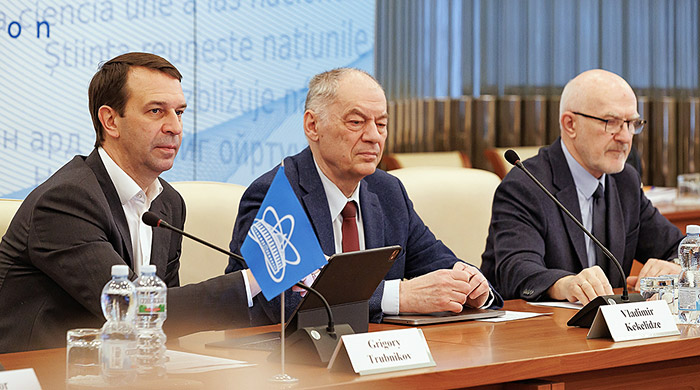
The Scientific Council supported all the recommendations of the PAC on the estimation of new projects and the prolongation of current projects on particle physics within the proposed deadlines and rating.
The first report on the progress of the Nuclotron-NICA project was presented by Deputy Head of the VBLHEP Accelerator Department for Research Anatoly Sidorin. The key achievements of 2024 include: approval of the preliminary schedule for commissioning the collider, preparation for producing a charged particle beam from the KRION source, the HILAC accelerator, testing the production of a beam from the Nuclotron and later, the Nuclotron-Collider beam transport line. In June 2024, the technological launch of the NICA accelerator complex started, that is, tests of the power supply, high-frequency and other systems were carried out. In total, four launches of the KRION source were held, two more launches with the HILAC accelerator were carried out to prepare for beam accumulation in the booster and operation of the SOCHI station. During the year, magnetic technology was developed, dipole magnet tests were successfully implemented, channels for applied research were prepared and the collider's cryomagnetic system was assembled.
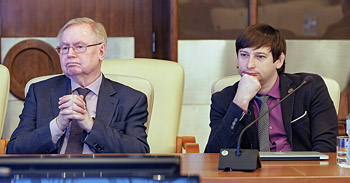 This year, from January to March, adjustment of cryogenics, power supplies, optimization of beam dynamics, adjustment of electron cooling, accumulation of the beam at the injection energy are scheduled on the booster. In April - May, the joint work of the booster and Nuclotron will be debugged, namely, minimization of particle losses, adjustment of slow extraction, the programme of BM@N and ARIADNA experiments will be carried out, testing of the fast extraction system will be implemented. In June - August, the start of operation of the collider is scheduled: adjustment of the Nuclotron-Collider beam transport line, beam injection into the collider, first collisions with the internal target.
This year, from January to March, adjustment of cryogenics, power supplies, optimization of beam dynamics, adjustment of electron cooling, accumulation of the beam at the injection energy are scheduled on the booster. In April - May, the joint work of the booster and Nuclotron will be debugged, namely, minimization of particle losses, adjustment of slow extraction, the programme of BM@N and ARIADNA experiments will be carried out, testing of the fast extraction system will be implemented. In June - August, the start of operation of the collider is scheduled: adjustment of the Nuclotron-Collider beam transport line, beam injection into the collider, first collisions with the internal target.
The Committee highly estimated the significant progress made in preparation for commissioning of the NICA collider, including the installation of the collider's magnetic cryostat system, RF stations and final focusing lenses, the unification of the high-vacuum sections in the western and eastern semi-rings, the positioning of cryogenic equipment and power supplies in the collider building and the connection of power transmission lines and energy evacuation systems. A detailed programme for the physical start-up of the complex has been developed. It includes the adjustment of the complex components while completing the assembly of the collider and the transport line in parallel. Several channels for applied research are ready for operation and five launches have already been carried out at the SOCHI chip irradiation station.
The PAC members listened with interest to the report by VBLHEP Deputy Chief Engineer Konstantin Mukhin on the readiness of the engineering infrastructure of Building 17 for the launch of the NICA collider and the MPD detector this year. The license for the construction of the radiation source (NICA collider) and the permit of the Federal Service for Environmental, Technological and Nuclear Supervision of Russia (Rostekhnadzor) for the operation of the VBLHEP main electrical substation were obtained in 2024. The Committee highlighted with satisfaction the readiness of the engineering equipment of the water-cooling systems, the power supply of the collider and the MPD detector for operation with colliding beams. The high degree of readiness of the collider cryogenic support system was also positively obtained: additional refrigerators and a new cryogenic compressor station were successfully launched, as well as the installation and testing of liquid helium pipelines feeding the collider. The PAC congratulates the staff on the successful completion of a significant milestone - cooling the MPD superconducting magnet to operating temperatures of 4.5-5 K (from -268.65 to -268.15°C). The PAC members also welcomed the automation of engineering systems.
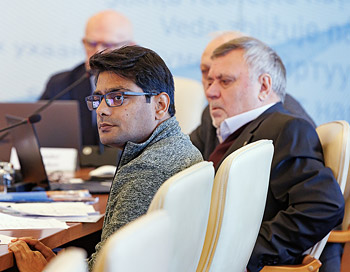 The progress in the implementation of the BM@N project was highly estimated at the PAC meeting. The report was presented by Head of the VBLHEP Department Mikhail Kapishin. The article describing the full configuration of the BM@N detectors in the first physical launch of the Xe ion beam with a CsI target was published in NIMA (Nuclear Instruments and Methods, Series A). The preliminary results on the neutron emission spectra at large angles and the direct proton flux in Xe+CsI interactions were presented in the report. The physical results on the production of protons, deuterons and tritons in argon-nucleus interactions at an energy of 3.2 A GeV are currently discussed in the BM@N collaboration. The next physical launch of the BM@N experiment is scheduled with a Xe beam with an energy of 2-3 A GeV.
The progress in the implementation of the BM@N project was highly estimated at the PAC meeting. The report was presented by Head of the VBLHEP Department Mikhail Kapishin. The article describing the full configuration of the BM@N detectors in the first physical launch of the Xe ion beam with a CsI target was published in NIMA (Nuclear Instruments and Methods, Series A). The preliminary results on the neutron emission spectra at large angles and the direct proton flux in Xe+CsI interactions were presented in the report. The physical results on the production of protons, deuterons and tritons in argon-nucleus interactions at an energy of 3.2 A GeV are currently discussed in the BM@N collaboration. The next physical launch of the BM@N experiment is scheduled with a Xe beam with an energy of 2-3 A GeV.
The PAC took note of the status report on the SPD project presented by DLNP Deputy Director Alexey Guskov. Having completed the technical design, SPD specialists have started work on the first stage of the detector that includes a superconducting solenoid magnet, a muon system, a main tracker based on straw detectors and a central tracker based on Micromegas technology. In addition, a pair of zero-angle calorimeters and beam collision counters, as well as an electromagnetic calorimeter will be developed. The fabrication of the detector's main system components has started. Progress has been made in developing the project's computing infrastructure. The PAC encourages the SPD collaboration to carry out further work on designing the first stage of the facility.
The PAC took note of the progress report on the MPD project presented by the collaboration spokesman Viktor Ryabov. In 2020-2024, the main components of all detector subsystems of Phase I were manufactured, including the time-projection chamber TPC, the time-of-flight system TOF, the electromagnetic calorimeter ECal, the forward fast detector FFD and the forward hadron calorimeter FHCal. Assembly, testing and calibration are currently underway. Extensive work on the assembly and commissioning of the solenoid superconducting magnet has been completed. A test cooling of the magnet to liquid helium temperature was successfully completed at the end of 2024. A comprehensive programme of investigations of the detector operation and the analysis of the physics programme has been carried out. The MPD upgrade programme for Phase II will start after the analysis of these investigations. The PAC members recommended to test whether the MPD construction and installation can be accelerated to match the collider startup schedule and, on the whole, to prolong the MPD project for five years with an A rating.
The report "Investigation of neutrino properties in accelerator experiments" about JINR's participation in the accelerator neutrino experiments NOvA, T2K, FASER and DsTau was presented by Deputy Head of Department of DLNP Lyudmila Kolupaeva. All these experiments are aimed at studying the fundamental properties of neutrinos at accelerators with well-controlled particle sources. Over several years, JINR groups have made significant and diverse contributions to the development of these experiments and data analysis and group members have taken a number of coordinating positions in collaborations. The presented project unites JINR's participation in these experiments that will allow using the experience of the participating groups. Given the significant role of the JINR group in the NOvA experiment, as well as the prospects for its scientific contribution to the T2K, FASER and DsTau experiments, the PAC recommends opening the project from 2026 for a period of three years with an A rating.
The reports on the results of the LHC research obtained by the JINR groups were presented by: leading researcher Elena Rogochaya in the ALICE collaboration, Head of Sector of DLNP Ivan Eletskikh in the ATLAS experiment, Head of Department of VBLHEP Vladimir Karzhavin in the CMS experiment. In general, the significant contribution of the JINR groups to the modernization of detectors, data analysis, preparation of scientific publications and presentations at international conferences, workshops and seminars are highlighted at the PAC meeting with approval.
Scientific reports for the Committee members were given by senior researcher of VBLHEP Maria Patsiuk - "Status of the SRC programme in the HyperNIS+SRC project" and senior researcher of BLTP Alexey Zhevlakov - "Investigation of dark matter physics in fixed target experiments".
At the poster session, 17 reports by young scientists from DLNP and VBLHEP were presented. The Committee members selected the report "Construction of ISKRA and SIMBO stations for applied research on high-energy ion beams. Investigation of radiation resistance of microcircuits on pulsed beams of low-energy ions at the SOCHI station" by senior engineer of VBLHEP Department No.1 Alexey Slivin for presentation at the next session of the Scientific Council in February 2025.
The next meeting of the PAC for Particle Physics is scheduled for 23-24 June.
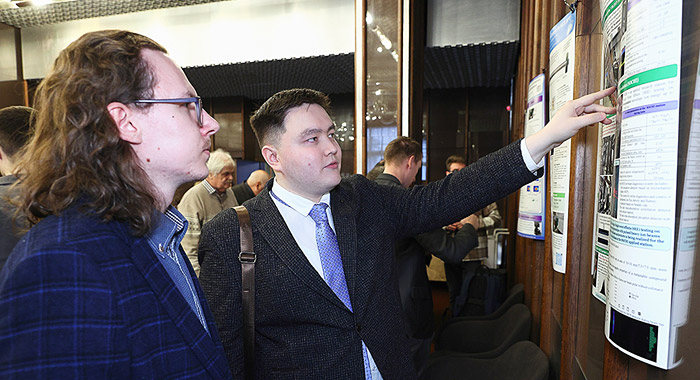

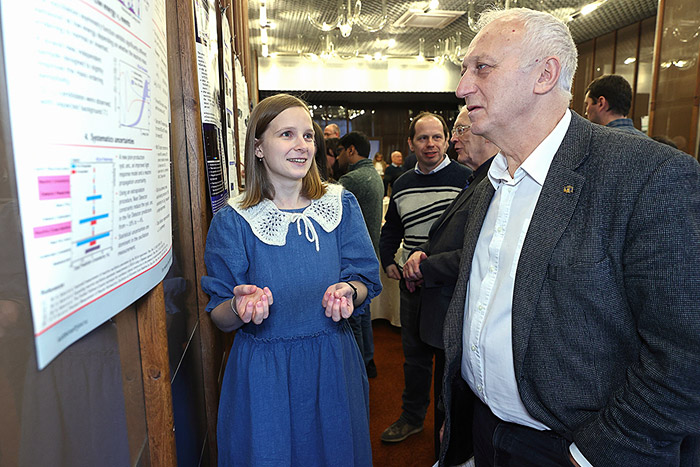
Galina MYALKOVSKAYA,
Photo by Elena PUZYNINA, Igor LAPENKO